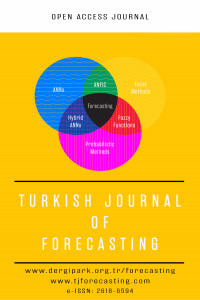Stock Market Prediction Using Nonparametric Fuzzy and Parametric GARCH Methods
Stock Market Prediction Using Nonparametric Fuzzy and Parametric GARCH Methods
Prediction of stock market value is one the most complicated issue during the past decades. Due to its importance, in this research, we consider the prediction of stock values based on non-parametric and parametric methods. In this first method, we use the fuzzy Markov chain procedure in order to prediction problem. In this regard, all of the rising and falling probabilities during the weekdays are calculated and then they applied to obtain the increasing and decreasing rate. Then, based on this information we model and predict the stock values. In the sequel, we implement different methods of parametric time series such as generalized autoregressive conditionally heteroskedastic (GARCH), ARIMA-GARCH, Exponential GARCH (E-GARCH) and GJR-GARCH by assuming the normal and t-student distribution for the error terms to obtain the best model in terms of minimum mean square errors. Finally, the mythologies developed here are applied for the Tehran Stock Exchange Index (TEDPIX).
Keywords:
Conditional variance, Error distribution, Fuzzy prediction Markov chain, Stock exchange, Volatility models,
___
- 1. Alexander, C. and Lazar, E., 2006, Normal mixture GARCH (1, 1): application to exchange rate modeling. Journal of Applied Econometrics Economic Review, 39: 885–905.
- 2. Alexander, C. and Lazar, E., 2004, The equity index skew, market crashes and asymmetric normal mixture GARCH. ISMA Center Discussion Papers in Finance, 14.
- 3. Andersen, T. G. and Bollerslev, T., 1998, Answering the skeptics: Yes, standard volatility models provide accurate forecasts. International Economic Review, 39: 885-905.
- 4. Baillie, R. T. and Bollerslev, T., 1989, Common stochastic trends in a system of exchange rates. Journal of Monetary Economics, 44: 167-181.
- 5. Baillie, R. T., Bollerslev, T. and Mikkelsen, H. O., 1996, Fractionally integrated generalized autoregressive conditional heteroskedasticity. Journal of Econometrics, 74: 3-30.
- 6. Bollerslev, T., 1986, Generalized autoregressive conditional heteroscedasticity. Journal of Econometrics, 31: 307-327.
- 7. Bollerslev, T. and Mikkelsen, H. O., 1996, Modeling and pricing long memory in stock market volatility. Journal of Econometrics, Elsevier, vol. 73(1): 151-184.
- 8. Bollerslev, T., Chou, R. Y. and Kroner, K. F., 1992, ARCH modeling in finance: A review of the theory and empirical evidence. Journal of Econometrics, 52: 5-59.
- 9. Engle, R. F., 1982, Autoregressive conditional heteroscedasticity with estimates of the variance of United Kingdom inflation. Econometrics, 50: 987–1007.
- 10. Engle, R. F. and Bollerslev, T., 1986, Modeling the persistence of conditional variances, Econometric Reviews. Taylor and Francis Journals, vol. 5(1): 1-50.
- 11. Engle, R. F., 2001, GARCH 101: The use of ARCH/GARCH models in applied econometrics. Journal of Economic Perspectives, vol. 15(4): 157–168.
- 12. Engle, R. F., 2002, New frontiers for ARCH models. Journal of Applied Econometrics, 17:425–446.
- 13. Glosten, L., Jangannathan, R. and Runkle, D., 1993, On the relation between excepted value and the volatility of the nominal excess return of stocks. Journal of Finance, 48:1779-1801.
- 14. Jiang, W. 2012, Using the GARCH model to analyze and predict the different stock markets, Master thesis, Uppsala university.
- 15. Nelson, D., 1991, Conditional heteroscedasticity in asset returns: a new approach. Econometrics, 59: 349–370.
- 16. Wang, K-L, Fawson, C., Barrett, C.B. and J. B. McDonald (2001). A flexible parametric GARCH model with an application to exchange rates. Journal of Applied Econometrics, 16, 521-536.
- 17. Wang, Y., F., Cheng, S., Hsu, M., H. 2010, Incorporating the Markov chain concept into fuzzy stochastic prediction of stock indexes, Applied Soft Computing, 10, 613–617
- Yayın Aralığı: Yılda 2 Sayı
- Başlangıç: 2017
- Yayıncı: Giresun Üniversitesi
